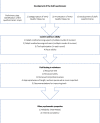WHO standards-based tools to measure service providers' and service users' views on the quality of hospital child care: development and validation in Italy
- PMID: 35301202
- PMCID: PMC8932272
- DOI: 10.1136/bmjopen-2021-052115
WHO standards-based tools to measure service providers' and service users' views on the quality of hospital child care: development and validation in Italy
Abstract
Objectives: Evidence showed that, even in high-income countries, children and adolescents may not receive high quality of care (QOC). We describe the development and initial validation, in Italy, of two WHO standards-based questionnaires to conduct an assessment of QOC for children and young adolescents at inpatient level, based on the provider and user perspectives.
Design: Multiphase, mixed-methods study.
Setting, participants and methods: The two questionnaires were developed in four phases equally conducted for each tool. Phase 1 which included the prioritisation of the WHO Quality Measures according to predefined criteria and the development of the draft questionnaires. In phase 2 content face validation of the draft questionnaires was assessed among both experts and end-users. In phase 3 the optimised questionnaires were field tested to assess acceptability, perceived utility and comprehensiveness (N=163 end-users). In phase 4 intrarater reliability and internal consistency were evaluated (N=170 and N=301 end-users, respectively).
Results: The final questionnaires included 150 WHO Quality Measures. Observed face validity was excellent (kappa value of 1). The field test resulted in response rates of 98% and 76% for service users and health providers, respectively. Among respondents, 96.9% service users and 90.4% providers rated the questionnaires as useful, and 86.9% and 93.9%, respectively rated them as comprehensive. Intrarater reliability was good, with Cohen's kappa values exceeding 0.70. Cronbach alpha values ranged from 0.83 to 0.95, indicating excellent internal consistency.
Conclusions: Study findings suggest these tools developed have good content and face validity, high acceptability and perceived utility, and good intrarater reliability and internal consistency, and therefore could be used in health facilities in Italy and similar contexts. Priority areas for future research include how tools measuring paediatric QOC can be more effectively used to help health professionals provide the best possible care.
Keywords: epidemiology; paediatrics; quality in health care.
© Author(s) (or their employer(s)) 2022. Re-use permitted under CC BY-NC. No commercial re-use. See rights and permissions. Published by BMJ.
Conflict of interest statement
Competing interests: None declared.
Figures
References
-
- UNICEF, WHO, World Bank, UN-DESA Population Division . Levels & trends in child mortality report 2020. Estimates developed by the U Inter-Agency Group for Child Mortality Estimation. Geneva: United Nations Children’s Fund, 2020. https://www.unicef.org/reports/levels-and-trends-child-mortality-report-...
-
- World Health Organization . Situation of child and adolescent health in Europe. World Health Organization, 2018.
-
- World Health Organization, OECD & International Bank for Reconstruction and Development . Delivering quality health services: a global imperative for universal health coverage. World Health Organization, 2018. https://apps.who.int/iris/handle/10665/272465
-
- Van de Maat J, van de Voort E, Mintegi S, et al. Research in European pediatric emergency medicine Study Group. antibiotic prescription for febrile children in European emergency departments: a cross-sectional, observational study. Lancet Infect Dis 2019;19:382–39. - PubMed
Publication types
MeSH terms
Grants and funding
LinkOut - more resources
Full Text Sources


